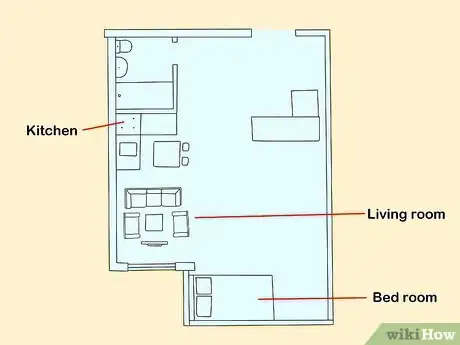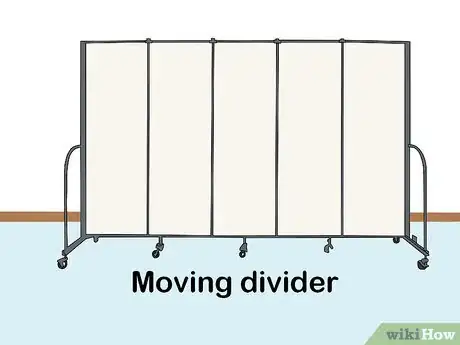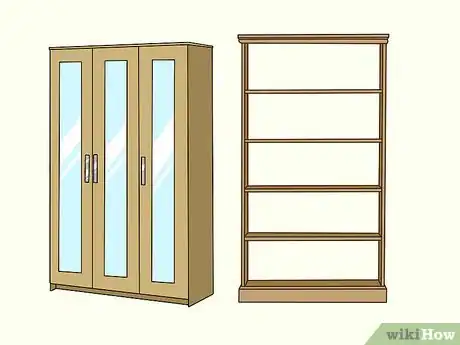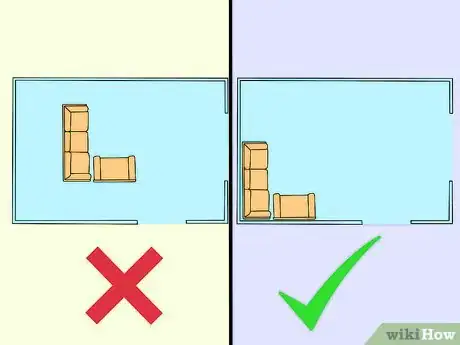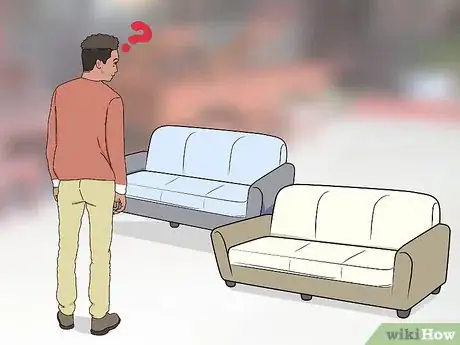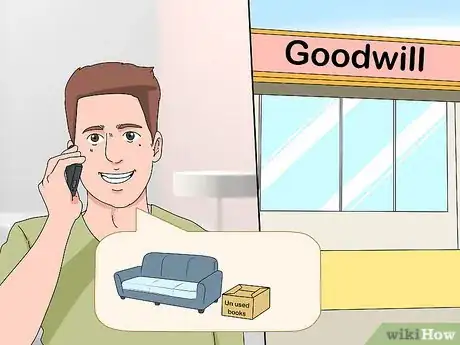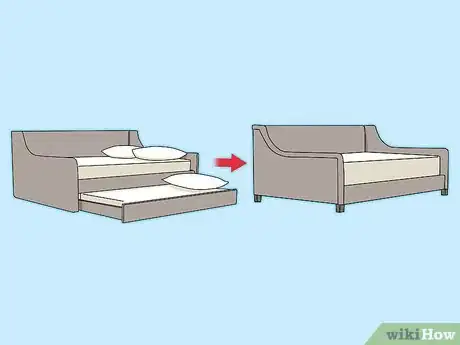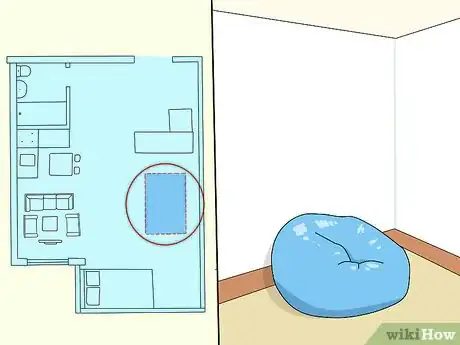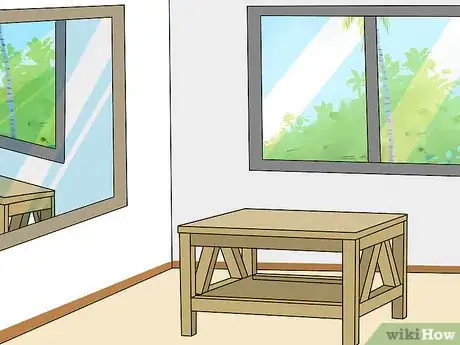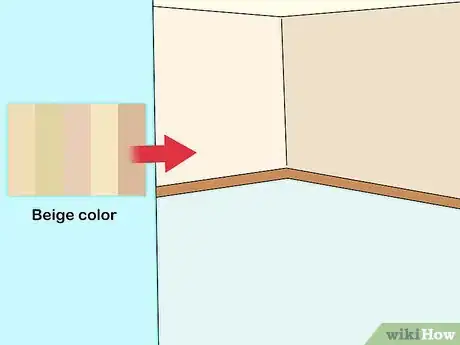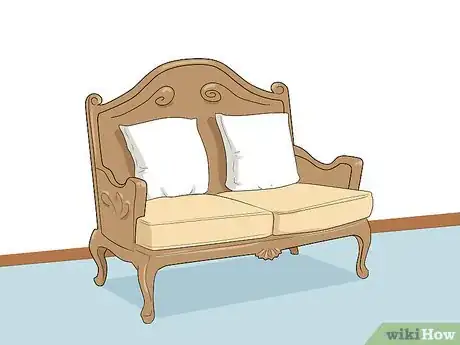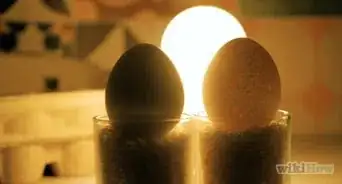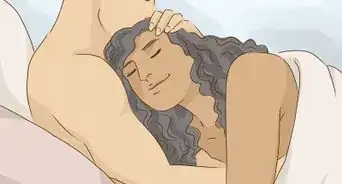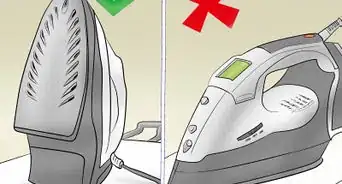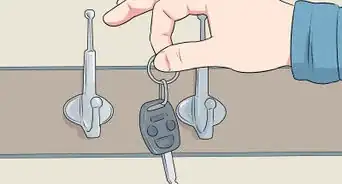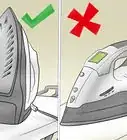This article was co-authored by Christel Ferguson. Christel Ferguson is the owner of Space to Love, a decluttering and organization service. Christel is certified in Advanced Feng Shui for Architecture, Interior Design & Landscape and has been a member of the Los Angeles chapter of the National Association of Productivity & Organizing Professionals (NAPO) for over five years.
There are 9 references cited in this article, which can be found at the bottom of the page.
wikiHow marks an article as reader-approved once it receives enough positive feedback. In this case, 93% of readers who voted found the article helpful, earning it our reader-approved status.
This article has been viewed 135,788 times.
Studio apartments combine the meat and potatoes of a house into a small space by putting a bedroom, kitchenette, and living room in one. Decorating a studio apartment for the first time can seem daunting, but the key is giving every inch of space a purpose. Small areas can seem spacious if you know how to trick the eye and utilize multi-purpose furniture. If you appreciate a minimalistic style, decorating a studio apartment may be just up your alley.
Steps
Arranging Furniture
-
1Use furniture to divide your apartment into "sub-rooms." The main room of a studio functions as three spaces in one: a bedroom, living room, and kitchen. You can create the feeling of three separate rooms by using the furniture to section off areas.
- Couches, armchairs, or loveseats can box off a "living room" area. Your bed can similarly separate your sleeping area.
- Rugs, coffee tables, or shelves can anchor your apartment furniture and make your apartment sub-rooms feel more organized.
-
2Place the bed directly against a wall. Your bed should be placed either parallel or perpendicular to a wall. If you place your bed in the center of the room, your studio will feel cramped and cluttered. Consider investing in a day bed or pull-out bed if you are short on space.
- For additional space, choose a low-rise bed without a frame. This will prevent your bed from obstructing windows or blocking up extra space.[1]
-
3Install moveable dividers. Incorporating dividers can help you separate your studio apartment into separate areas. When guests are over, you can divide off your sleeping area for a sense of privacy. Folding screen or ceiling-mounted drapes can take up minimal space in your studio when they're not being used.
- Try to section off the room into aesthetically-pleasing ratios. Room sections look most pleasing to the eye if they are divided up into 1/3 or 2/3 proportions.[2]
-
4Think vertically with storage space. To get the most out of your shelves, choose ones that are tall and thin. You will be able to utilize more space for your belongings without choosing a massive storage system. A large bookshelf or wardrobe can serve as a great separator between your sleeping area and living area.
- Placing high shelves above doorways or windows can also draw the eye upward (again giving the impression of a larger space) and give you more space in your studio.
-
5Choose furniture with visible legs. The furniture you choose can help with the illusion of space. Couches or chairs with visible legs (as opposed to legs draped over with cloth) create a feeling of light and airiness. The space between the floor and your furniture will help with an open floor plan.[3]
-
6Clear a pathway. Avoid setting your furniture in the middle of the room, where it can block your space from one end to the other. Pushing most of your furniture to the edges will maximize open space and avoid a claustrophobic atmosphere. Assess this by walking from one end of the studio to the other. If you can do so without much hassle, you have a clear pathway.
-
7Pick your furniture carefully. When arranging furniture in studio apartments, pick quality over quantity: too many chairs or sofas in a small space can leave you feeling trapped. When making the choice between two small couches or one large one, always opt for the latter.[4]
Creating Space
-
1Keep only the essentials. Choosing to live in a studio apartment means doing without unnecessary items. Go through your belongings and only keep your must-haves. Get rid of worn-out clothes, books you no longer read, and furniture that only gets in the way.[5]
- Donate your old belongings to a charity to put them towards a good use. Contact your local thrift store, Salvation Army, or Goodwill.
- If you struggle with de-cluttering, hire a professional organizer to help.[6]
-
2Choose items that are multi-functional. Every inch of floor in your apartment needs to be used effectively. Investing in some sturdy, dual-purpose furniture can help you make the most of your studio apartment. Consider buying a trundle bed that folds into a sofa or coffee tables that double as benches.[7]
- Buy furniture from companies that specialize in minimalist decor or micro-living. They will likely have dual-purpose furniture options fitting for studio apartments.
-
3Identify all "dead space" and repurpose it. Once you have set up a basic layout for your furniture and belongings, look for areas in the apartment that are not being used. Look for large patches of blank walls or empty corners. Brainstorm ways you could repurpose those empty areas in a way that best serves your needs.
- For example, if the right hand corner of your studio is empty, you could place a beanbag there. You can then repurpose into a reading or relaxing area.
- Don't go overboard and cram every area of your apartment with stuff. Some empty space is good and contributes to the balance of an apartment. Just make sure that each area has a purpose.
-
4Strategically place mirrors to make the room feel larger. A well-placed mirror can make your apartment feel twice as big as it is. Placing mirrors across from a window reflects natural light and makes the room feel more spacious. You could also place a mirror across from a large end table or shelf to make it look like an entire space is tucked into the mirror.[8]
Personalizing Your Apartment
-
1Choose light, neutral color schemes. If you can paint the walls, stick with neutral colors like beige or light pastels: neutrals have an expanding effect and can make an apartment look larger than it is. They also create a sense of warmth and balance.
-
2Vary decoration with textures. Too many colors will become over-stimulating in small spaces. You will have to be creative when giving diversity to your decorations. Having a singular color theme and mixing up different textures is the ideal way to add vibrancy. You could buy furniture with intricate carvings and decorate them with plush, fluffy pillows.
-
3Follow the "cantaloupe rule" with decorations. Avoid large, glaring items when decorating your studio apartment. According to the "cantaloupe rule," any accents larger than a cantaloupe crowd small rooms. Pick a few choice items that are larger, but aim for most decorations to be compact.[9]
- For example, instead of a large lamp that takes up a lot of space, you could opt for a small desk lamp. This will give you enough light to read or work when dark without using much space.
-
4Decorate with bold, dramatic art to make the apartment feel expansive. For studio apartments, shy away from landscapes or classical paintings. Instead, pick bold designs with lots of action. Modern art, especially pop art, is an excellent choice for studio apartments.
- Again, shy away from pieces with too much variance in color.
- The cantaloupe rule does not necessarily apply to artwork. Instead of two or three smaller art pieces, choose one bold canvas that makes a statement. With art in small spaces, too much hanging on the walls can become overwhelming.
Community Q&A
-
QuestionWhat about laundry services?
 Community AnswerYou can purchase a laundry machine, go to the cleaners, or use the laundry facilities at your complex if they offer any.
Community AnswerYou can purchase a laundry machine, go to the cleaners, or use the laundry facilities at your complex if they offer any. -
QuestionShould I get rid of books I was planning on reading later?
 Community AnswerNo, just get rid of any books that you don't plan on reading in the future.
Community AnswerNo, just get rid of any books that you don't plan on reading in the future. -
QuestionHow do I know which colors are appropriate for selling the apartment and which ones are not?
 Community AnswerGo for basic, calming colors. Use tones of white and grey. That said, a feature wall or bold color can add personality. Best advice is to pick a "theme," such as modern/ contemporary and research colors which appeal to the market you want to sell to. If you are scared, paint basic, light, grey-toned colors. Avoid warm colors, like orange or red.
Community AnswerGo for basic, calming colors. Use tones of white and grey. That said, a feature wall or bold color can add personality. Best advice is to pick a "theme," such as modern/ contemporary and research colors which appeal to the market you want to sell to. If you are scared, paint basic, light, grey-toned colors. Avoid warm colors, like orange or red.
References
- ↑ https://www.youtube.com/watch?v=ZrMBFoH_d8M
- ↑ http://chestofbooks.com/food/household/A-Manual-Of-Home-Making/Room-Shape-And-Proportion.html#.U_lkqUiVspM
- ↑ https://www.crateandbarrel.com/ideas-and-advice/furniture-for-small-spaces
- ↑ http://www.housebeautiful.com/room-decorating/living-family-rooms/g2310/small-living-room-decorating-ideas/?slide=5
- ↑ https://greatist.com/happiness/hoard-no-more-art-throwing-stuff-away
- ↑ http://www.huffingtonpost.com/entry/professional-organizer_us_57729368e4b0f168323af853
- ↑ http://www.decoist.com/2012-03-30/furniture-for-a-compact-living-space/
- ↑ http://www.apartmenttherapy.com/5-perfect-ways-to-use-mirrors-in-small-spaces-168900
- ↑ http://www.womansday.com/home/decorating/a4892/10-tricks-to-make-your-home-look-bigger-106806/
About this article
To decorate a studio apartment, create the feeling of separate rooms by boxing off a living room area with a sofa and chairs, or putting a folding screen between your living and sleeping areas. Additionally, use items that are multi-functional, like coffee tables that double as benches, to maximize your space. You can also choose tall, thin shelves to take advantage of unused air space. If you want to make your place seem more spacious, try putting mirrors across from a window to reflect natural light throughout your apartment. For more tips, like how to use color and texture to enhance your studio apartment, read on!
